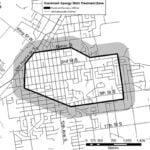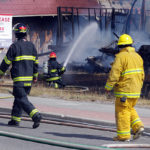Home »

Does speeding actually cause crashes?
Many drivers believe speeding alone does not actually cause crashes. While not totally inaccurate, this over-simplified phrase does not paint the whole picture. The fact is, very few crashes are caused by one factor alone, and this includes speeding, but downplaying the impact of speeding can prove to be deadly.
Some drivers try to justify a bit of extra speed. Their opinion being it’s safe and of no consequence or, quite frankly, they feel justified by their logic of everybody else does it. Or perhaps once a person has been driving for a few years and maybe had no crashes the thought is its okay to go a few kilometres over the speed limit, right? Ever heard the excuse, “the police don’t give out tickets for just five or 10 km/h over the speed limit?”
This thought process is dangerous as a lot has to do with the laws of physics and reaction times. Let me explain.
There is an old traffic joke that goes, “Physics; the only laws that drivers cannot break” so, if you don’t like what follows, you can blame Newton and all of his science pals.
Here are the facts and some real police scenarios to help it all make sense.
Fact number one
The faster the vehicle is travelling, the further it will take to stop. Without evasive driver action a collision is likely to happen.
A non-scientific perspective would assume that if something is going twice as fast as it was a minute ago, it will be twice as hard to stop, right? But, it doesn’t work like that. If a vehicle’s speed has been doubled a rough rule-of-thumb is a vehicle will take about four times as far to stop under braking. Check out table 1 for stopping distances. Keep in mind the braking distances in this table are for dry roads in good condition.
Fact number 2
The faster a car is travelling, the less time a driver will have to react to a hazardous situation.
To actually determine the true stopping distance for a vehicle, you must take into account the time it will take for the driver to perceive a threat, react to that threat and then take evasive action. Very few can use their ‘best’ reactions in an emergency.
Most of us can do well on an actual test of reaction time in a controlled environment. Testing has shown the average reaction time would be 1.5 seconds. For example, when a light flashes or a specific sound is activated we have to press a button. In that situation we have awareness; we know a light is going to come on or a buzzer will activate so we are ready, with our finger on the button and muscles tensed. But real life is different. Real life is not controlled and driver reaction times are much higher.
So, if we apply a minimum reaction time of 2.0 seconds in an uncontrolled environment, we can see the distance travelled during that decision phase and subsequently calculate the total stopping distance of a vehicle.
You can see the total stopping distance is reliant on the driver’s ability to react in a prompt manner and the capabilities of the vehicle to stop under different road and weather conditions, and this is all based on the primary factor of the initial SPEED of the vehicle.
In addition to the science, there are also several factors, which can influence a driver’s perception and response time. These factors can be broken down into two categories:
1) Human Factors
- Drivers’ ability to perceive a threat;
- Fatigue;
- Alcohol / drug consumption;
- Distractions within the vehicle (passengers, children, eating/drinking, putting on make-up, reading a book or map);
- Cell Phones (even hands-free phone conversations significantly increase the risk of a serious crash as it will affect your concentration on the task of driving.
2) Environmental Factors
- Road and weather conditions (fog, rain, snow, sleet, etc.);
- Darkness, direct sunlight;
- View obstructions (other vehicles of different sizes, trees, bushes, buildings, etc.);
- Visual clutter (too many reflected and illuminated signs, flashing lights, traffic signals).
Today’s driver has a lot to process and complacency or over confidence can easily set in.
Typical quotes I have heard include, “I’ve been driving for 30 years and never had a crash” or “I’ve driven this road a thousand times; I know every bump and twist.” The scary fact is, anybody driving while thinking about anything other than their driving at any moment is a distracted driver.
I get it, nobody is a robot, and nobody can concentrate at 100% for 100% of the time, especially on longer journeys. However, a key difference between unsafe drivers and safer drivers is the safer ones think only about their driving for a much larger proportion of the time, and that takes effort.
Fact number 3
The more extreme evasive action taken by a driver to avoid a collision, the more likely they are to cause a secondary collision or involve other road users in the incident before even reaching the original hazard.
There are three ways to make a vehicle respond to what you are demanding of it; steering, accelerating and braking.
Most drivers will place an excessive amount of steering input (swerving) in an emergency. Subsequently, this will cause a car to travel beyond the intended path in order to avoid a hazard. This creates a ripple effect involving other users of the road and, in some unfortunate situations, places your vehicle into oncoming traffic. For example, swerving can sometimes be successful on a racetrack (a somewhat controlled environment) where everyone is ultra-alert and travelling in one direction. The fact is, in the real world there are often vehicles beside you, behind and in front of you and, in the worst-case scenario, approaching you. Oh, and don’t forget the bicycles and pedestrians that are also using the shoulders of the roadway!
It takes as little as a quarter turn on the steering wheel to travel from one lane to another at 80 km/h. Add excessive speed to the equation and we are back to the capability of the vehicle and driver’s reaction time to stop before the hazard.
Fact number 4
The faster a vehicle is travelling at the moment of impact, the greater the damage will be, the more serious the injuries and the higher the risk of death.
I’m going to use two real police file examples to explain this one. Tragically these were fatalities I investigated which illustrated the deadly consequences of SPEED.
Scenario 1:
It’s a 6:30 a.m. dark, stormy morning with torrential rain pouring down. A driver is travelling on a two-lane road that has a posted speed limit of 50 km/h. The driver suddenly reacts to an elderly pedestrian crossing the road within a marked and lit crosswalk. The driver applies the brakes (evasive action) but slides through the crosswalk striking the pedestrian before the vehicle comes to a stop.
The evidence at scene enabled me to determine the vehicle was travelling at a minimum speed of 75 km/h at the time evasive action was taken. Subsequently, the pedestrian was hit at a vehicle speed of 52 km/h and tragically died as a result of the injuries sustained.
Without changing any parameters prior to the evasive action and assuming the vehicle was travelling at the posted speed limit of 50 km/h when the brakes were applied, the pedestrian would have been hit at a vehicle speed of 23 km/h. Therefore, there was a very strong likelihood the injuries would not have been fatal.
In this scenario, the driver was charged and convicted of the Criminal Code offence of dangerous driving causing death which carries a maximum penalty of 14 years imprisonment.
Scenario 2:
At 7:30 p.m. on a clear, dry summer’s evening a vehicle is travelling down a two-lane roadway with a speed limit of 50 km/h. The driver noted a child riding their bicycle along the shoulder of the road going in the same direction as they were. The child suddenly cuts in front of the vehicle. The driver takes action by steering left (swerving) and braking (evasive) but still strikes the child. The driver flees the scene but is arrested a short distance away.
The evidence at scene enabled me to determine the vehicle was travelling at a minimum speed of 80 km/h at the time evasive action was taken, with the child being hit at a vehicle speed of 59 km/h. Again, another tragedy as the child died as a result of the injuries sustained.
Without changing any parameters prior to the evasive action and assuming the vehicle was travelling at the posted speed limit of 50 km/h when the brakes were applied, the vehicle would have stopped 2.44 meters short of hitting the child.
This driver was charged and convicted of the Criminal Code offences of Dangerous Driving causing Death (maximum penalty of 14 years) and Hit and Run causing Death which carries a maximum penalty of imprisonment for life.
Conclusion
Are you still with me? I recognize this has been a long article but I appreciate you reading through. Most people refer to crashes or collisions as an “accident.” That word is never used by Collision Reconstructionist Analysts.
The Oxford Dictionary describes an accident as “an undesirable or unfortunate happening that occurs unintentionally and usually results in harm, injury or damage.” If you are speeding then a crash or a collision is anything but an accident. It is actually an intentional act by the driver to break the law.
Now that you know all this, what would your explanation or defense for speeding be? Or even worse what would it be if you caused a fatal crash because you were speeding? Was it somehow an unavoidable “accident” or rather a dangerous choice you made to SPEED?
Lead image: A vehicle recovery following a crash east of the Elko tunnel on Highway 3 earlier this summer. e-KNOW file photo
– Sgt. Bruce McCowan is currently in charge of the Ridge Meadows Traffic Services. A RCMP member for over 31 years, he is also a Forensic Collision Reconstructionist.








